Traditional Love Songs of English-speaking countries (матеріали до уроку)
Даний матеріал є клопіткою роботою вчителя і буде цікавим під час вивчення традицій англомовних країн. Вчителю він буде незамінним під час проведення уроків,тематичних свят та різноманітних заходів.
Traditional Love Songs of English-speaking countries
(матеріали до уроку)
Вчитель англійської мови
Веселинівської загальноосвітньої школи I – III ступенів
Миколаївської області
Латій Ольга Олександрівна
Plan
- Love music. Traditional Love songs in English – speaking countries.
- Traditional Love songs in English – speaking countries:
- Daisy Bell
- My love is like a red, red rose
- Greensleeves
- Oh! Susanna
- I gave my love a cherry
- Annie Laurie
- Billy Boy
- All around my hat
- Bold Young Farmer
- Foggy, Foggy Dew
- The Banks of Roses
- I Love My Jean
- Summarizing
Love is an abstract idea that can't really be explained. Music is a tool that helps convey feelings of love better than words alone can. Sometimes love needs to be sung because music is the language of love.[1]
In ancient times, all poetry was sung. The poet is pictured playing a lyre or other instrument. There was no separation of lyrics and melody as we now think of them. Unfortunately none of the melodies for these early love lyrics has survived but it's easy to imagine a softly strummed harp and a husky voice singing the words that have come down to us.
Though they are thousands of years old, the earliest love songs sound so contemporary, so honest, so urgent, they might have been written yesterday. They are proof that human emotions have not changed. When we fall in love today, we feel what men and women felt in centuries past: desire, joy, disappointment, yearning, fulfillment.
So just how far back can we trace love songs? When Pharoah Rameses wanted to tell a beautiful, bronze-skinned Egyptian lady that he found her desirable, did he have a court musician sing something that sounded like "Love Me Tender"? In a way, he did. We have recovered 3500-year-old Egyptian love poems from pieces of papyrus and pottery fragments. They are filled with the language and sentiments we hear in today's pop songs.
The oldest written record of love songs comes from an area around the Tigris and Euphrates rivers known as Sumeria. The cone-shaped cuneiform script of Sumer was pressed into clay tablets which have survived to this day, giving us a glimpse into the Top 40 songs - or, at any rate, the lyrics - of 4000 years ago. These poem/songs were written in praise of the Sumerian gods and goddesses, notably Inana, a Moon and fertility goddess, and Dumiz (or Tamuz), a god of crops and fields. But like the later Hebrew "Song Of Songs," the religious context seems slight indeed. The songs speak to us of the very real emotions of young lovers, sensual pleasure, and romantic encounters.[2]
A love song is about falling in love and the feelings it brings. Anthologies of love songs often contain a mixture of both of these types of song.[3]
 Love songs touch people in a way that nothing else can. They can sway the most prideful person to forgive. Love songs help you remember when and why you fell in love. Love songs are for every season, every person, and every relationship. Love songs generally consist of falling in love, meeting someone for the first time, missing someone who is not with you, or heart break.[4]
Love songs touch people in a way that nothing else can. They can sway the most prideful person to forgive. Love songs help you remember when and why you fell in love. Love songs are for every season, every person, and every relationship. Love songs generally consist of falling in love, meeting someone for the first time, missing someone who is not with you, or heart break.[4]
There are different types of themes for songs. You have songs for weddings, romantic country songs, cheesy teenage songs about their love, R&B romantic songs, heavy metal rock ballads, jazz songs are talking about love, blues deals with this subject, and yes, reggae is not immune to love. Love songs say we will get through this. You have for example Phil Collins hit "Against All Odds". Some love songs say it hurts but it's worth it as in Pat Benatar's "Love is a Battlefield". Some of the songs embrace the bliss and euphoria of being with your soul mate as in Stevie Wonder's "Overjoyed". There are songs that say it'll be alright and it's us against the world as in Bon Jovi's "You Were Born to be My Baby".
In the 15th through the early 17th centuries, music began to be printed and sold. Musical themes spread rapidly throughout Europe, particularly those developed by the troubadours of Provence in earlier centuries. With the coming of the Renaissance, the Church lost some of its power to control ideas. The notion of courtly love, so distasteful to the clergy, was widely celebrated in the cultural centers of Europe. It was only occasionally taken seriously in the courts and castles of the elite, but its imagery was inviting and it sounded good.
During the reign of Elizabeth I, Shakespeare, like other playwrights, sprinkled songs throughout his stage plays. We don't have the original melodies but, like Greensleeves, they were probably sung to well-known tunes of the day, whichever ones the actors happened to know. Although Shakespeare's love sonnets are deeply moving, the love songs in his plays tend to be more for laughs.
Fairs and religious festivals were among the very few occasions when young people could meet and spend time together. Therefore, they play a central role in several folk love ballads. "Scarborough Fair" is a love song that is also a riddle song as is another well known folk ballad, "I Gave My Love A Cherry." Both songs are at least 400 years old.
The 1600's gave birth of some of the most enduring English and Irish love ballads; these were folk songs, written anonymously, that told of unrequited or lost love. Their haunting melodies and evocative lyrics have ensured their continuous popularity over the centuries despite changing tastes in music. In my opinion, these are some of the most beautiful love songs ever written. You can hear echoes of them today in such hits as "My Heart Will Go On" and
"The First Time Ever I Saw Your Face."
Songs from this period include "Scarborough Fair," "Black Is The Color Of My True Love's Hair," "The Water Is Wide," and "She Moved Through the Fair." According to Ossian's "Folksongs and Ballads" the melody of "She Moved Through the Fair" dates back to Medieval times but the lyrics, as we generally know them today, were probably written in the 1600's. Along with "Greensleeves," it is the earliest love song still widely sung today.
As population centers grew, the 1700's saw an increase in the public's desire for entertainment and, by extension, songs that aimed to please. Taverns provided an opportunity for raucous, musical merriment. Tavern songs were often lewd, recounting the charms of loose women and the amorous adventures of well-endowed sailors and soldiers. But they could also be sentimental, cry-in-your-tankard songs of virtuous maids left behind at home.
During the same period, the Scottish poet Robert Burns wrote love poems of enduring beauty, many of which were set to existing tunes. "My Love Is Like A Red, Red Rose" was known widely at the time and is still sung today, as are "Sweet Afton" and "Green Grow The Rushes." The 19th century saw the gradual rise of popular songwriting as a profession. Thomas Moore, a noted composer, satirist, and musician living in Dublin, writer of the evergreen classic "Believe Me If All Those Endearing Young Charms," created a multi-volume work titled Irish Melodies containing 130 of his poems set to music by Moore and Sir John Stevenson. The work was a smash hit earning Moore five hundred pounds a year for more than 25 years, an enormous sum at the time.
Stephen Collins Foster is considered to be the first professional songwriter in America and one of its greatest. He painstakingly wrote and rewrote his songs until he was satisfied, creating both original lyrics and melodies. Although he garnered wide recognition during his lifetime, due to a combination of personal problems and business deals gone bad, he died in poverty. Among his love songs are such classics as “Oh! Susanna", “Jeanie With the Light Brown Hair," "Beautiful Dreamer," and "Wilt Thou Be Gone Love."[5]
Folk Music Site gives us such songs of love as:[6]
True Love
- Abroad As I Was Walking
- Ailie Bain O' The Glen
- Annie Laurie
- Argyle is My Name
- As I Walked Through the Meadow (1)
- As I Walked Through the Meadow (2)
- At the Sign of the Bonny Blue Bell
- The Bailiff's Daughter of Islington
- Ballynamony
- The Banks of the Roses
- Believe Me If All Those Endearing Young Charms
- Bells of Aberdovy
- Billy Boy (American)
- Billy Boy (English)
- Billy Boy (Irish)
- Black-Eyed Susan
- Black is the Color of My True Love's Hair
- Blow, Ye Winds, Blow
- Blow the Candles Out
- The Bold Soldier
- Bonnie Lesley
- Bonnie Lizzie Baillie
- The Bonny Lighter Boy
- The Briery Bush
- Britons, Strike Home
- The Broom of Cowdenknows
- By A Bank As I Lay (2)
- By A Bank As I Lay (1)
- Captain Wedderburn's Courtship
- Child Waters
- Come Back Paddy Reilly
- Come Live With Me
- Corydon and Phyllis
- Dainty Davie
- My Darling Ploughman Boy
- Derry Down Dale
- Drink To Me Only With Thine Eyes
- Eileen Arun
- Enraptured I Gaze
- Eriskay Love Lilt
- Fair Margaret and Sweet William (1)
- Fair Margaret and Sweet William (2)
- Fairest Gwen (Mentra Gwen)
- Farewell, Nancy
- Farewell to Lochaber
- The Female Highwayman
- Flow Gently Sweet Afton
- The Gaberlunzie Man
- Gaily the Troubadour
- The Gallant Hussar
- The Gallant Weaver
- Gentle Gwen
- Geordie
- Glenlogie
- Gypsy Rover
- Here's Adieu to All Judges and Juries
- Hi for the Beggarman
- High Germany
- Huntingtower
- I Know Where I'm Going
- I'll Never Leave Thee
- I'll Take You Home Kathleen
- I'm Seventeen Come Sunday
- The Irish Girl
- Jackaroe
- Jock O'Hazeldean
- Johnie Scot
- Johnny Lad
- The Jolly Young Waterman
-
Joy Upon Thy Bright Cheek Dances
(Hob Y Deri Dando) - Kathleen O'Moore
- The Keys of Canterbury
- The Knight and the Shepherd's Daughter
- The Lass o' Gowrie
- The Lass of Patie's Mill
- The Lass of Richmond Hill
- Lavender's Blue
- Leezie Lindsay
- The Little Turtle Dove
- Logan Water
- Lord Bateman
- Lord Thomas of Winesberry
- The Lost Lady Found
- Love Will Find Out The Way
- The Low-Back'd Car
- Maggie Lauder
- Maid of Llanwellyn
- Mairi Bhan Og
- Mountains of Mourne
- My Johnny Was a Shoemaker
- My Love is Like a Red Red Rose
- Ned of the Hill (2)
- Norah, Dear Norah
- Nut Brown Maiden
- Gin I Were a Baron's Heir
- Nannie, Wilt Thou Gang Wi' Me?
- Oh No, John! (1)
- Oh No, John! (2)
-
One Bright Summer Morning
(Cadair Idris) - Our Ship She Lies in Harbour
- Over the Hills and Far Away (1)
-
The Ploughboy
(The Lark in the Morn) - Pretty Maid Milking a Cow
- The Pretty Ploughboy
- Pretty Polly Oliver
- Pretty Saro
- The Rich Nobleman and His Daughter
- The Rolling of the Stones
- The Rose of Tralee
- Rosetta and Her Gay Ploughboy
- Roslin Castle
- Sally In Our Alley
- Savourneen Deelish
- Scarborough Fair
- Scottish Wedding
- The Sheffield Apprentice
- Snowy Breasted Pearl
- A Soldier and a Sailor
- The Soldier's Return
- The Star of the County Down
- Sweet Lovely Joan
- Sweet Rosie O'Grady
- Tam Glen
- Through Moorfields
- To the Weavers Gin Ye Go
- True Lover's Farewell
- Undaunted Mary
- The Wealthy Farmer's Son
- When the Kye Comes Hame
- White Wings
- Will Ye Go Lassie?
- William and Mary
- The Willow Tree (Irish)
- Within a Furlong of Edinborough Town
- Within a Mile of Edinburgh Town
- The Wraggle Taggle Gypsies, O!
- And Ye Shall Walk in Silk Attire
- The Yellow Hair'd Laddie
- The Young Servant Man
Sad and Tragic Love[7]
- All Round My Hat
-
The Ash Grove (1)

- The Ash Grove (2)
- The Barkshire Tragedy
- Bedlam
- Bessie Bell and Mary Gray
- Blackbirds and Thrushes
- Bonnie George Campbell
- The Bonnie House o' Airlie
- The Bonnie Lass of Fenario
- The Bonny Lass of Fyvie
- The Bonny Light Horseman (1)
- The Bonny Light Horseman (2)
- The Braes of Yarrow
- Brother's Revenge
- Bruton Town
- Carrigfergus
- Cockles and Mussels
- The Cruel Mother
- The Cruel War (1)
- The Cruel War (2)
- The Death of Queen Jane
- Donald and Flora
- Down by the Salley Gardens
- The Drowned Lover
- The Duke of Bedford
- Earl Brand
- Earl Colvin
- Fair Helen of Kirkconnell
- Fair Janet
- The Fair Sailor Lad
- Fine Flowers in the Valley
- The Foggy, Foggy Dew
- The Four Marys
-
A Gentle Maid In Secret Sighed
(Erddigan Hun Gwennlliam) - George Collins
- The Ghost Lover
- Gil Morice
- Gilderoy
- Green Bushes
- Heavy the Beat of the Weary Waves
- House Carpenter (English Version)
- House Carpenter (Canadian Version)
- I Must Live All Alone
- Johnny's Gone for a Soldier (1)
- Johnny's Gone for a Soldier (2)
- Johnny's Gone for a Soldier (3)
- Kelvingrove
- Lady Maisry
- Lady Margaret
- Lilly Dale
- Lord Lovel
- Lord Rendal
- Lord Thomas and Fair Ellinor
- Lost Jimmy Whelan
- Mary's Dream
- The Missing Boat (Yn Nyffryn Clwyd)
- Molly Brannigan
- Nae Mair We'll Meet Again
- The Nobleman's Wedding
- Oh, Breathe Not His Name
- Polly Vaughn
- Rare Willie
- Sad Am I and Sorrow-Laden
- She is Far From the Land
- She Moved Through the Fair
- Shule Agra
- The Soldier's Farewell
- Still Growing
- The Three Ravens
- The Trees They Do Grow High (1)
- The Trees They Do Grow High (2)
- The Twa Corbies
- The Twa Sisters
- The Unquiet Grave
-
The Water is Wide
(O Waly, Waly) - When He Who Adores Thee
- Will Watch
- Who is at My Window Weeping?
Unhappy Love, False Love, and Seduction
- A Bold Young Farmer
- As I Roved Out One Morning
- As I Walked Forth
- The Banks of the Sweet Primroses
- Billy Taylor
- The Blacksmith
- Blow the Candle Out
- Brimbledon Fair
- A Brisk Young Sailor
- Cold Haily Rainy Night
- Dabbling in the Dew
- The Deceived Maid
- Early One Morning
- The Fair Maid of Islington
- Fair Susan
- The Foggy Dew (1)
- Good Morning, Pretty Maid
- The Great Silkie of Sule Skerry (1)
- The Great Silkie of Sule Skerry (2)
- Greensleeves
- The Gypsy Laddie
- Hares on the Mountains (1)
- Hares on the Mountains (2)
- Hughie Graham
- I Climb the Mountains (Fhir A Bhata)
- I Dreamt I Dwelt in Marble Halls
- I Pass All My Hours
- Johnny Faa
- Katy Cruel
- Lily of the West
- Lord Gregory
- Love Me Little, Love Me Long
- Madam, Will You Walk?
- Mary of the Moor
- Mary Queen of Scots' Lament
- Mattie Groves
- Moggy Lawder
- My Lodging It Is On the Cold Ground
- Near Woodstock Town
- The Nightingale
- On the Banks of the Allan Water
- O Sally, My Dear
- Once I Loved A Maiden Fair
- The Outlandish Knight
- Peggy Bawn
- Poor Sally Sits A-Weeping
- Prince Elphin's Song
- Reynardine
- Rolling in the Dew
- The Saucy Sailor Boy
- Seeds of Love
- She's Like a Swallow
- Some Rival Has Stolen My True Love Away
- Sweet Joan
- Sweet is the Budding Spring of Love
- Sweet William
- Tam Lin
- Thou Art Gane Awa'
- The Trooper and the Maid
- Two Maids Went Milking One Day
- The Two Magicians
- William Taylor
- The Willow Tree (American)
- The Woods So Wild
- Ye Banks and Braes o' Bonnie Doon
- Young Rambleaway
Unrequited Love
- Alice Gray
- Ally Croaker
- Barbara Allen
-
Belfast Mountains

- Blow Away the Morning Dew
- Dear Evelina, Sweet Evelina
- Eileen Oge
- Galway City
-
I Once Loved a Lass
(The False Bride) -
Idle Days in Summer Time
(Bugeilio R Gwenith Gwyn) - Kate Kearney
- The Laird o' Cockpen
- Lady Mary
-
The Lady of Sker
(Y Ferch O'r Scer) - The Lakes of Pontchartrain
- Londonderry Air
-
Megan's Fair Daughter
(Merch Megan) - The Maid Who Sold Her Barley
- Richard of Taunton Dean
- Roy's Wife of Aldivalloch
- The Spanish Lady (1)
- Spanish Lady (2)
- The Willow Tree (English)
The Battle of the Sexes[8]
- The Farmer's Curst Wife
- Hard is the Fortune
- John Grumlie
- Kellyburnbraes
- Old Maid in the Garret
- Ruggleton's Daughter of Iero
- Tho' Women's Minds
- The Time I've Lost in Wooing
- The Well of St. Keyne
- A Woman's Work is Never Done
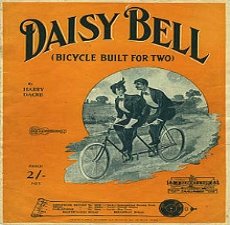 People know this song as "Daisy, Daisy", "A Bicycle Built for Two", and as "Daisy Bell". The original name for the song is "Daisy Bell"…[9]
People know this song as "Daisy, Daisy", "A Bicycle Built for Two", and as "Daisy Bell". The original name for the song is "Daisy Bell"…[9]
"Daisy Bell" became a hit in 1892. It was written by Englishman Harry Dacre in the US, and there's an interesting story behind it… He came to the US in 1891 with his bicycle. When he landed in New York, the customs officers made him pay a duty on his bike. He was outraged by this and complained about it to people for months to come. One day, a person replied to his complaint, "You're lucky it wasn't a bicycle built for two"!
The phrase "bicycle built for two" stuck in Dacre's mind and he wrote the song based on it.
People still sing this song today, though many only know the chorus…
There is a flower
Within my heart,
Daisy, Daisy!
Planted one day
By a glancing dart,
Planted by Daisy Bell!
Whether she loves me
Or loves me not,
Sometimes it's hard to tell,
Yet I am longing to share the lot
Of beautiful Daisy Bell!
Chorus
Daisy, Daisy,
Give me your answer do!
I'm half crazy,
All for the love of you!
It won't be a stylish marriage,
I can't afford a carriage
But you'll look sweet upon the seat
Of a bicycle built for two.
We will go 'tandem'
As man and wife,
Daisy, Daisy!
"Ped'ling" away
Down the road of life,
I and my Daisy Bell!
When the road's dark
We can both despise
P'licemen and "lamps" as well,
There are "bright lights"
In the dazzling eyes
Of beautiful Daisy Bell!
Daisy, Daisy,
Give me your answer do!
I'm half crazy,
All for the love of you!
It won't be a stylish marriage,
I can't afford a carriage
But you'll look sweet upon the seat
Of a bicycle built for two.
I will stand by you
In "wheel" or woe*,
Daisy, Daisy!
You'll be the bell(e)
Which I'll ring you know,
Sweet little Daisy Bell!
You'll take the "lead"
In each "trip" we take,
Then if I don't do well,
I will permit you to
Use the brake,
My beautiful Daisy Bell!
Daisy, Daisy,
Give me your answer do!
I'm half crazy,
All for the love of you!
It won't be a stylish marriage,
I can't afford a carriage
But you'll look sweet upon the seat
Of a bicycle built for two.
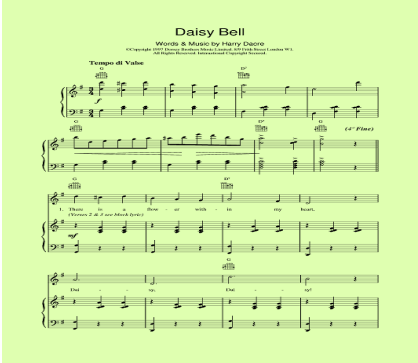
![]()
Robert Burns was a master at writing love poetry and setting it to music. His love songs are still sung around the world and nobody could say 'I love you' better than he.’ [10] 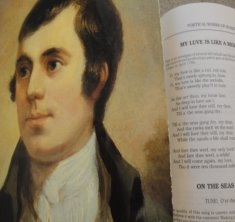
Robert Burns knew what it was to be in love. He fell in love regularly, from the age of 15 when he met a lass named Nelly, till the day he died. He flirted with Jessy, the lass sent to help his wife Jean, care for him in his last illness. Jean missed his funeral as she had gone into labour with their son, Maxwell.
During his brief lifetime, (he was only 37 when he died in 1796) he wrote many poems (over 300 between 1786 and his death) on a variety of subjects but his love songs are among his best known. He was not the most faithful of husbands, having several illegitimate children to various women, and numerous affairs but remained with his wife, Jean Armour, whom he married in 1788.
His songs still echo the feelings of being in love and resonate down the years.
"My Love is Like a Red, Red Rose" is a 1794 song in Scots by Robert Burns based on traditional sources. The song is also referred to by the title My Love is Like A Red, Red Rose or Red, Red Rose and is often published as a poem.
Burns worked for the final ten years of his life on projects to preserve traditional Scottish songs for the future. In all, Burns had a hand in preserving over 300 songs for posterity, the most famous being "Auld Lang Syne". He worked on this project for James Johnson's The Scots Musical Museum (1787-1803) and for George Thomson's five-volume A Select Collection of Original Scottish Airs for the Voice. Burns had intended the work to be published as part of Thomson's selection. However, he wrote to a friend that Thomson and he disagreed on the merits of that type of song. "What to me appears to be the simple and the wild, to him, and I suspect to you likewise, will be looked on as the ludicrous and the absurd." [11]
Instead, Burns gave the song to Scots singer Petro Urbani who published it in his Scots Songs. In his book, Urbani claimed the words of The Red Red Rose were obligingly given to him by a celebrated Scots poet, who was so struck by them when sung by a country girl that he wrote them down and, not being pleased with the air, begged the author to set them to music in the style of a Scots tune, which he has done accordingly. In other correspondence, Burns referred to it as a "simple old Scots song which I had picked up in the country."
The lyrics of the song are simple but effective. "My luve's like a red, red rose/That's newly sprung in June" describe a love that is both fresh and long lasting. David Daiches in his work describes Burns as "the greatest songwriter Britain has produced" for his work in refurbishing and improving traditional Scots songs including "Red, Red Rose" which he described as a "combination of tenderness and swagger."
Urbani published the song to an original tune that he wrote. The song appeared in Johnson's Museum in 1797 to the tune of Neil Gow's "Major Graham" which was the tune that Burns wanted. In 1799, it appeared in Thomson's Scottish Airs set to William Marshall's Wishaw's Favourite with the lyric "And fare thee weel awhile" changed.
The song became more popular when Robert Archibald Smith paired it with the tune of "Low Down in the Broom" in his Scottish Minstrel book in 1821. This has become the most popular arrangement. The song has been widely performed by a range of artists in the 20th and 21st centuries including Jean Redpath, Pat Boone, Kenneth McKellar, the Fureys, Eddi Reader, Camera Obscura, Eva Cassidy, Izzy, and Ronnie Browne of the Corries (in his solo album after Roy Williamson's death, 'Scottish Love Songs'(1995)).
Robert Schumann composed a setting of a German translation of Burns's poem in 1840.
Four modern choral arrangements include a four-part, a cappella version by David Dickau, an intimate, Irish folk music-influenced setting, also SATB a cappella, by Matthew Brown ("A Red, Red Rose," published by Santa Barbara Music), an accompanied SATB setting by James Mulholland as well as a broader version by American composer René Clausen. Clausen's arrangement incorporates a piano, two violins, and a four-part chorus. (SATB) A Swedish translation and recording named "Min älskling (du är som en ros)" was made famous by the renowned Swedish musician Evert Taube.
Carly Simon sang a solo version of "A Red, Red Rose" on the album The Simon Sisters Sing The Lobster Quadrille And Other Songs For Children that she produced with her sister Lucy Simon. A version of Oh My Love is like a Red, Red Rose by Italian singer Ariella Uliano was performed with classical guitar accompaniment on the album Leave Only Your Footsteps Behind.
The lyrics were further used by Mr. Allen Epley for the vocals on "Final Breath" by the post-rock band Pelican on their latest album "what we all come to need".
O my Luve's like a red, red rose
That’s newly sprung in June;
O my Luve's like the melodie
That’s sweetly play'd in tune.
As fair art thou, my bonnie lass,
So deep in luve am I:
And I will luve thee still, my dear,
Till a’ the seas gang dry:
Till a’ the seas gang dry, my dear,
And the rocks melt wi’ the sun:
I will luve thee still, my dear,
While the sands o’ life shall run.
And fare thee well, my only Luve
And fare thee well, a while!
And I will come again, my Luve,
Tho’ it were ten thousand mile.
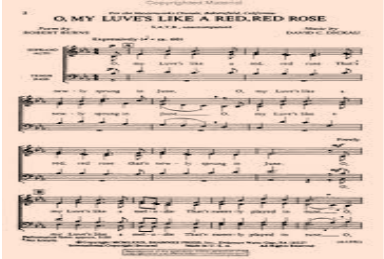
![]()
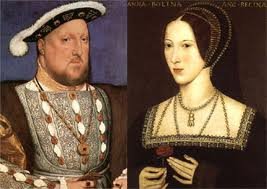 Greensleeves" is a traditional English folk song and tune, a ground of the form called a romanesca.[12]
Greensleeves" is a traditional English folk song and tune, a ground of the form called a romanesca.[12]
There is a legend that King Henry VIII wrote Greensleeves about Anne Boleyn. This is not likely, however, because the song is written in a style which was not known in England until after Henry VIII died.[13]
The earliest known mention of Greensleeves occurred in September 1580, when a printer named Richard Jones had licensed to him "A new Northern Dittye of the Lady Greene Sleeves". On that same day, printer Edward White also had a license for "A ballad, being the Ladie Greene Sleeves Answere to Donkyn his frende".
Thus began a back and forth struggle between the printers for the rights to this beautiful melody, with various versions being published. It was not until 1584 that Jones printed his final version, which is the one we know today.
The tune is found in several late 16th century and early 17th century sources, such as Ballet's MS Lute Book and Het Luitboek van Thysius, as well as various manuscripts preserved in the Cambridge University libraries.
Alas, my love, you do me wrong,[14]
To cast me off discourteously.
For I have loved you well and long,
Delighting in your company.
Chorus:
Greensleeves was all my joy
Greensleeves was my delight,
Greensleeves was my heart of gold,
And who but my lady greensleeves.
Alas, my love, that you should own
A heart of wanton vanity,
So must I meditate alone
Upon your insincerity.
(Chorus)
Your vows you've broken, like my heart,
Oh, why did you so enrapture me?
Now I remain in a world apart
But my heart remains in captivity.
(Chorus)
If you intend thus to disdain,
It does the more enrapture me,
And even so, I still remain
A lover in captivity.
(Chorus)
I have been ready at your hand,
To grant whatever you would crave,
I have both wagered life and land,
Your love and good-will for to have.
(Chorus)
Thou couldst desire no earthly thing,
But still thou hadst it readily.
Thy music still to play and sing;
And yet thou wouldst not love me.
(Chorus)
I bought thee kerchiefs for thy head,
That were wrought fine and gallantly;
I kept thee at both board and bed,
Which cost my purse well-favoredly.
(Chorus)
I bought thee petticoats of the best,
The cloth so fine as it might be;
I gave thee jewels for thy chest,
And all this cost I spent on thee.
(Chorus)
Thy smock of silk, both fair and white,
With gold embroidered gorgeously;
Thy petticoat of sendal right,
And these I bought thee gladly.
(Chorus)
My men were clothed all in green,
And they did ever wait on thee;
All this was gallant to be seen,
And yet thou wouldst not love me.
(Chorus)
They set thee up, they took thee down,
They served thee with humility;
Thy foot might not once touch the ground,
And yet thou wouldst not love me.
(Chorus)
'Tis, I will pray to God on high,
That thou my constancy mayst see,
And that yet once before I die,
Thou wilt vouchsafe to love me.
(Chorus)
Ah, Greensleeves, now farewell, adieu,
To God I pray to prosper thee,
For I am still thy lover true,
Come once again and love me.
Greensleeves was all my joy
Greensleeves was my delight,
Greensleeves was my heart of gold,
And who but my lady greensleeves.
William Shakespeare mentions this song by name twice in The Merry Wives of Windsor. In Act Two, "I would have sworn his disposition would have gone to the truth of his words; but they do no more adhere and keep place together than the Hundredth Psalm to the tune of 'Green Sleeves' "; and in Act Five, "Let the sky rain potatoes; let it thunder to the tune of 'Green Sleeves.'[15]
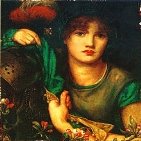 One possible interpretation of the lyrics is that Lady Green Sleeves was a promiscuous young woman and perhaps a prostitute. At the time, the word "green" had sexual connotations, most notably in the phrase "a green gown", a reference to the way that grass stains might be seen on a woman's dress if she had engaged in sexual intercourse out-of-doors.
One possible interpretation of the lyrics is that Lady Green Sleeves was a promiscuous young woman and perhaps a prostitute. At the time, the word "green" had sexual connotations, most notably in the phrase "a green gown", a reference to the way that grass stains might be seen on a woman's dress if she had engaged in sexual intercourse out-of-doors.
An alternative explanation is that Lady Green Sleeves was, through her costume, incorrectly assumed to be immoral. Her "discourteous" rejection of the singer's advances supports the contention that she is not.
In Nevill Coghill's translation of The Canterbury Tales, he explains that "green [for Chaucer’s age] was the colour of lightness in love. This is echoed in 'Greensleeves is my delight' and elsewhere."[16]
"What Child Is This?" is a popular Christmas carol written in 1865 by William Chatterton Dix, set to the "Greensleeves" tune.
A variation was used extensively in the 1962 film How the West Was Won as the song "Home in the Meadow", lyrics by Sammy Cahn, performed by Debbie Reynolds. "Stay Away" is the theme of the 1968 film Stay Away, Joe performed by Elvis Presley set to the "Greensleeves" tune.
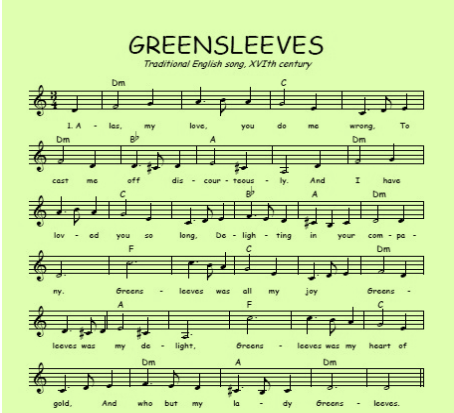
![]()
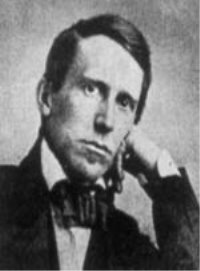 "Oh! Susanna" is a minstrel song by Stephen Foster (1826-1864). It was published by W. C. Peters & Co. in Cincinnati, Ohio in 1848. The song was introduced by a local quintette at a concert in Andrews' Eagle Ice Cream Saloon in Pittsburgh, Pennsylvania on September 11, 1847. Foster was said to have written the song for his men's social club. The name Susannah may refer to Foster's deceased sister Charlotte, whose middle name was Susannah.. Glenn Weiser suggests the song was influenced by an existing work, "Rose of Alabama" (1846), with which it shares some similarities in lyrical theme and musical structure.
"Oh! Susanna" is a minstrel song by Stephen Foster (1826-1864). It was published by W. C. Peters & Co. in Cincinnati, Ohio in 1848. The song was introduced by a local quintette at a concert in Andrews' Eagle Ice Cream Saloon in Pittsburgh, Pennsylvania on September 11, 1847. Foster was said to have written the song for his men's social club. The name Susannah may refer to Foster's deceased sister Charlotte, whose middle name was Susannah.. Glenn Weiser suggests the song was influenced by an existing work, "Rose of Alabama" (1846), with which it shares some similarities in lyrical theme and musical structure.
The first two phrases of the melody are based on the major pentatonic scale.[17]
The song tells a story about a man going to New Orleans to see his beloved Susanna. It's full of longing and desire, wherein the narrator dreams of Susanna at night and talks about "fall[ing] upon the ground" at first site of his love. By eliminating the violent racist verse, and singing it without the mock accent, it's a fairly tame love song that has worked its way into the hearts and history of American folk music. [18]
1.
I come from Alabama with my Banjo on my knee--
I’se gwine to Lou’siana my true lub for to see.
It rain’d all night de day I left, de wedder it was dry;
The sun so hot I froze to def -- Susanna, dont you cry.
Chorus:
Oh! Susanna, do not cry for me;
I come from Alabama, wid my Banjo on my knee.
2.
I jump’d aboard the telegraph and trabbeled down de ribber,
De lectrie fluid magnified, and kill’d five hundred Nigger.
De bullgine bust, de hoss ran off, I really thought I’d die;
I shut my eyes to hold my bref -- Susanna, dont you cry.
Chorus:
3.
I had a dream de udder night, when ebry ting was still;
I thought I saw Susanna dear, a coming down de hill.
De buckweat cake was in her mouf, de tear was in her eye,
I says, I’se coming from de souf, -- Susanna, dont you cry.
Chorus:
An unauthorized fourth verse was added:
4.
I soon will be in New Orleans, and den I’ll look all round,
And when I find Susanna, I' fall upon the ground.
But if I do not find her, dis darkie 'I surely die,
And when I'm dead and buried, Susanna, dont you cry.
Chorus:
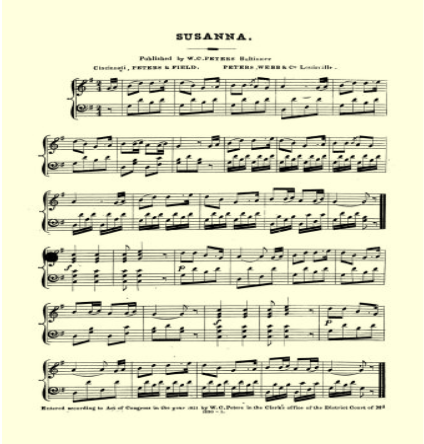
![]()
The Riddle Song," also known as "I Gave My Love a Cherry" is an English folk song, apparently a lullaby, which was carried by settlers to the American Appalachians.
It descends from a 15th-century English song in which a maiden says she is advised to unite with her lover. It is related to Child Ballad no. 1, or "Riddles Wisely Expounded" and Child Ballad no. 46 Burl Ives recorded it on 11 February 1941 for his debut album, Okeh Presents the Wayfaring Stranger. Since then, it has been recorded by many artists, including Pete Seeger, Joan Baez, Doc Watson, Sam Cooke, The Meters, and Carly Simon.
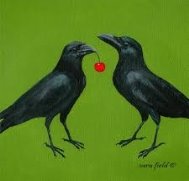 The song was featured in the famous toga party scene in the movie National Lampoon's Animal House, where John Belushi's character Bluto comes across a folk singer (portrayed by singer-songwriter Stephen Bishop, who is credited as "Charming Guy With Guitar") performing the song for a group of college girls. Bluto abruptly takes the singer's acoustic guitar out of his hands and smashes it, then hands a splintered piece of it back, saying "Sorry." Bishop told Songfacts that he and the film's musical director Kenny Vance came up with the idea for his folk singer character to perform "Cherry." "It seemed like the right song to do in the scene," he said. The song was also featured in the children's CD, the Song of the Unicorn. It only used two of the verses, and they were changed around a little bit.
The song was featured in the famous toga party scene in the movie National Lampoon's Animal House, where John Belushi's character Bluto comes across a folk singer (portrayed by singer-songwriter Stephen Bishop, who is credited as "Charming Guy With Guitar") performing the song for a group of college girls. Bluto abruptly takes the singer's acoustic guitar out of his hands and smashes it, then hands a splintered piece of it back, saying "Sorry." Bishop told Songfacts that he and the film's musical director Kenny Vance came up with the idea for his folk singer character to perform "Cherry." "It seemed like the right song to do in the scene," he said. The song was also featured in the children's CD, the Song of the Unicorn. It only used two of the verses, and they were changed around a little bit.
One version of the Riddle Song:
"I gave my love a cherry without a stone
I gave my love a chicken without a bone
I gave my love a ring that had no end
I gave my love a baby with no crying
How can there be a cherry that has no stone?
How can there be a chicken that has no bone?
How can there be a ring that has no end?
How can there be a baby with no crying?
A cherry when it's blooming it has no stone
A chicken when it's pipping, it has no bone
A ring while it's rolling, it has no end
A baby when it's sleeping, has no crying
The song's "cherry that has no stone" goes back to the 15th-century version's "the cherye with-outyn ony ston." Some have seen it as a reference to the hymen, and some have even tried to reconstruct an original bawdy version from which modern versions are supposedly bowdlerized. However, the relevant slang sense of "cherry" is not attested till the early 20th century. The other riddles in the original do not resemble the "reconstructions."[19]
Despite the popularity of the title "The Riddle Song", it is merely one of a multitude of riddle songs; the format is common through folk music.
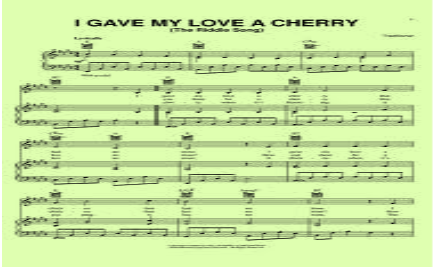
![]()
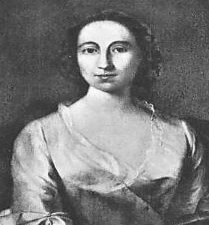 “Annie Laurie” is an old Scottish song based on poem by William Douglas (1672?-1748) of Dumfries and Galloway.
“Annie Laurie” is an old Scottish song based on poem by William Douglas (1672?-1748) of Dumfries and Galloway.
The words were modified and the tune was added by Alicia Scott in 1834/5. The song is also known as Maxwelton Braes. William Douglas became a soldier in the Royal Scots and fought in Germany and Spain and rose to the rank of captain. He also fought at least two duels. He returned to his estate at Fingland in 1694. Traditionally it is said that Douglas had a romance with Anna/Anne Laurie [20](16 December 1682, Barjarg Tower, in Keir, near Auldgirth, Scotland — 5 May 1764, Friars' Carse, Dumfries-shire, Scotland). Anna was the youngest daughter of Robert Laurie, who became first baronet of Maxwellton in 1685. The legend says that her father opposed a marriage. This may have been because Anna was very young; she was only in her mid-teens when her father died. It may also have been because of Douglas's aggressive temperament or more likely because of his Jacobite allegiances. It is known for certain that they knew of each because in a later letter by Anna she says in reply to news about Douglas, "I trust that he has forsaken his treasonable opinions, and that he is content."[21]
Douglas recovered from this romance and eloped with a Lanarkshire heiress, Elizabeth Clerk of Glenboig. They married in Edinburgh in 1706. Douglas's political beliefs forced him into exile. He became a mercenary soldier and sold his estate at Fingland in the 1720s, though eventually he received a pardon.
In Edinburgh in 29 August 1709 Anna married Alexander Fergusson, 14th Laird of Craigdarroch. (Early editions of Brewer's are in error claiming her husband was James Ferguson, who was in fact her son.) She lived at Craigdarroch for 33 years. Under her directions the present mansion of Craigdarroch was built, and a relic of her taste is still preserved in the formal Georgian gardens at the rear of the house. She was born on 16 December 1682, about 6 o'clock in the morning at Barjarg Tower, near Auldgirth, Scotland. Annie Laurie died on a Saturday, 5 April 1764, and some sources say she was buried at Craigdarroch. Portraits of her exist at Maxwelton and at Mansfield, the seat of the Stuart-Monteiths. The portraits show that she had blue eyes. There has been some doubt that Douglas composed the poem. The words of the second verse of the song may be based on an old version of John Anderson My Jo, to the tune of which song Annie Laurie was sometimes sung. The words were first recorded in 1823 in Sharpe's "Ballad Book", quite a long time after 1700. The song therefore may have been written by Allan Cunningham, who invented contributions to Sharpe's book. However Douglas is known to have written other verses and he also knew an Anna Laurie of Maxwelton. This seems to indicate he was the originator of some of the first verse at least.
The earliest known version, one that may be closest to what Douglas wrote, follows:
Maxwelton braes are bonnie, where early fa's the dew[22]
Where me and Annie Laurie made up the promise true
Made up the promise true, and ne'er forget will I
And for bonnie Annie Laurie I'd lay doun my head and die
She's backit like the peacock, she's breistit like the swan
She's jimp aboot the middle, her waist ye weel may span
Her waist ye weel may span, and she has a rolling eye
And for bonnie Annie Laurie I'd lay doun my head and die.
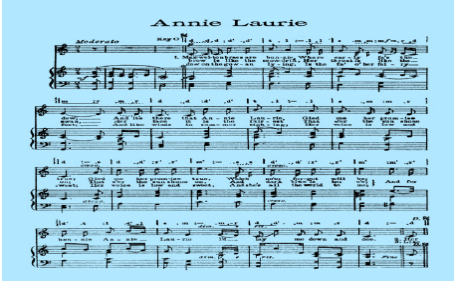
![]()
 "Billy Boy" is a traditional folk song and nursery rhyme found in the United States. It has a Roud Folk Song Index number of 326. Billy Boy is thought to be from 19th century England and was originally Willie Lad and Charming William.[23]
"Billy Boy" is a traditional folk song and nursery rhyme found in the United States. It has a Roud Folk Song Index number of 326. Billy Boy is thought to be from 19th century England and was originally Willie Lad and Charming William.[23]
In this song, Billy’s mother questions him about the girl he plans to marry. Like a mother in any country, she wants her son to find a wife who is polite (“Did she ask you to come in?”), attractive (“How tall is she?”), skillful and housekeeping (“Can she bake a cherry pie? Can she make a feather bed?”), young (“How old is she?”). In answering his mother, Billy exaggerates all the qualities of the girl he wants to marry; he is joking in a good – natured way.
One variant of the lyrics goes:[24]
Oh, where have you been,
Billy Boy, Billy Boy?
Oh, where have you been,
Charming Billy?
I have been to seek a wife,
She's the joy of my life,
She's a young thing
And cannot leave her mother.
Did she ask you to come in,
Billy Boy, Billy Boy?
Did she ask you to come in,
Charming Billy?
Yes, she asked me to come in,
There's a dimple in her chin.
She's a young thing
And cannot leave her mother.
Can she make a cherry pie,
Billy Boy, Billy Boy?
Can she make a cherry pie,
Charming Billy?
She can make a cherry pie,
Quick as a cat can wink an eye,
She's a young thing
And cannot leave her mother.
How old is she,
Billy Boy, Billy Boy?
How old is she,
Charming Billy?
Three times six and four times seven,
Twenty-eight and eleven,
She's a young thing
And cannot leave her mother.
Further variants have been recorded, that greatly extend the number of verses and tasks she can perform. An extended version of the song in which the lover performs many tasks besides the cherry pie was collected by Alan Lomax and John Avery Lomax: it appears in American Ballads and Folk Songs. The Lomax version names the woman being courted Betsy Jane.
The folk group, The Almanac Singers, wrote an anti-war version of this song by Millard Lampell.
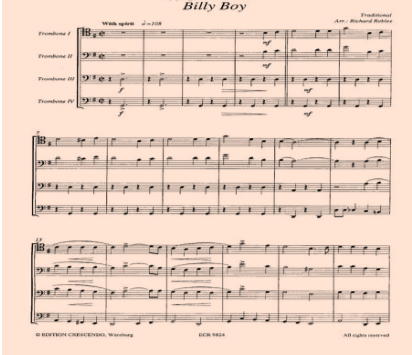
![]()
The song "All Around my Hat" (Roud 567, Laws P31) is of nineteenth century English origin.
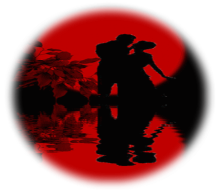 In an early version, dating from the 1820s, a Cockney costermonger vowed to be true to his fiancee, who had been sentenced to seven years' transportation to Australia for theft and to mourn his loss by wearing green willow sprigs in his hatband for "a twelve-month and a day," in a traditional symbol of mourning.
In an early version, dating from the 1820s, a Cockney costermonger vowed to be true to his fiancee, who had been sentenced to seven years' transportation to Australia for theft and to mourn his loss by wearing green willow sprigs in his hatband for "a twelve-month and a day," in a traditional symbol of mourning.
In Ireland, Peadar Kearney adapted the song to make it relate to a Republican lass whose lover has died in the Easter Rising, and who swears to wear the Irish tricolor in her hat in remembrance.
The versions by Steeleye Span and other artists are discussed below.[25]
A young man is forced to leave his lover, usually to go to sea. On his return he finds her on the point of being married to another man. In some versions he goes into mourning, with the green willow as a symbol of his unhappiness (willow is considered to be a weeping tree). In other versions he reminds her of her broken promise, and she dies mysteriously. In some versions he simply contemplates his lover left behind, without actually returning to find her being married. In other versions, the young man is a street hawker who is mourning his separation from his lover who has been transported to Australia for stealing.
The song has typical archetypal elements of the separated lovers, the interrupted wedding, and the inconsolable rejected lover. In the "Yellow Ribbon" variants, the adornment is a reminder of lost love, similar to Ireland's The Black Velvet Band.
Sailors are notoriously unfaithful, so this is an interesting twist, with the man being true, and the woman being inconstant.
The song is found in England and Canada, seafaring nations, but also in Scotland. In Ireland it has been adapted to a modern conflict - the Irish Republican movement.
The Bodleian Library has a version. This version has some cockney words.
Sabine Baring-Gould printed a version in "A Garland of Country Song" in 1895. This version is very close to the best known version, by Steeleye Span. The well-known soldier's song She Wore a Yellow Ribbon (as used in the John Ford film of the same name), has the words "Far away! Far away! She wore it for her soldier who was far, far away." This is probably a more recent variant of the nineteenth century song.
Jasper Carrot sang a parody "It's my bloody ribbon and it's my bloody hat" at the Cambridge folk Festival in 1976.
All Around My Hat[26]
All around my hat I will wear the green willow
All around my hat for a twelvemonth and a day,
And if anyone should ask me the reason why I'm wearing it
It's all for my true love who is far, far away
Fare thee well cold winter and fare thee well cold frost
Nothing have I gained but my own true love I've lost
I'll sing and I'll be merry when occasion I do see
He's a false deluding young man, let him go farewell he.
The other night he brought me a fine diamond ring
But he thought to have deprived me of a far better thing
But I being careful like lovers ought to be
He's a false deluding young man, let him go farewell he
Here's a half a pound of reason, and a quarter pound of sense
A small sprig of time and as much of prudence
You mix them all together and you will plainly see
He's a false deluding young man, let him go farewell he.
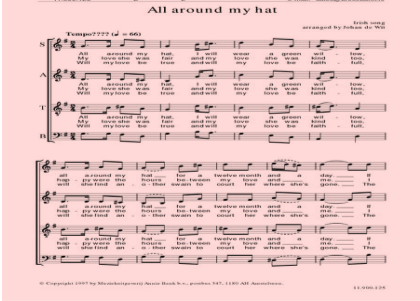
![]()
 "A Brisk Young Sailor (Courted Me)" (variously known as "Bold Young Farmer", "The Alehouse" and "Died For Love" amongst other titles) is a traditional Folk ballad (Roud # 60, Laws P25), which has been collected from all over Britain, Ireland and North America.
"A Brisk Young Sailor (Courted Me)" (variously known as "Bold Young Farmer", "The Alehouse" and "Died For Love" amongst other titles) is a traditional Folk ballad (Roud # 60, Laws P25), which has been collected from all over Britain, Ireland and North America.
A young sailor courts a young girl and wins her heart. But now he visits an alehouse in another town and entertains another. He is false and this other girl has more gold than she but that will waste along with her beauty. But our heroine still loves him dearly and besides she's carrying his child. Oh, what a foolish girl she was to have given her heart to a sailor.
In some versions she dies of a broken heart and in others he is not a sailor but a farmer or other unspecified young man.
The Traditional Ballad Index states that one 1891 source claims the song was written by an F. J. Adams but the wide variety of different versions collected from a wide area not long after this would tend to contradict that theory.
R. Vaughan Williams collected this song in Essex. It appeared in English County Songs (1908). Malcolm Laws relates it to Love Has Brought Me to Despair, Died for Love and A Brisk Young Sailor Courted Me.[27]
A Brisk Young Sailor[28]
A brisk young sailor courted me,
He stole away my liberty,
He stole my heart with a free good will,
I must confess I love him still.
Down in the meadows she did run,
A gathering flowers as they sprung,
Every sort she gave a pull,
Till she had gathered her apron full.
When first I wore my apron low,
He followed me through frost and snow,
But now my apron is up to my chin,
He passes by and says nothing.
There is an alehouse in this town,
Where my love goes and sits him down,
He takes another girl on his knee,
Why is not that a grief to me.
Ah, griev'd I am, I'll tell you why,
Because she has more gold than I,
Her gold will waste, her beauty blast,
Poor girl she'll come like me at last,
I wish my baby it was born,
Set smiling on its father's knee,
And I was dead and in my grave,
And green grass growing over me.
There is a bird all in yonder tree,
Some say 'tis blind, and cannot see,
I wish it had been the same by me,
Before I had gained my love's company,
There is a man on yonder hill,
He has a heart as hard as steel,
He has two hearts instead of one,
He'll be a rogue when I am gone.
But when they found her corpse was cold,
They went to her false love and told,
I am glad says he, she has done so well,
I long to hear her funeral knell,
In Abraham's bosom she does sleep,
While his tormenting soul must weep,
He often wished his time o'er again,
That his bride he might make her merry & marry her soon.
"Bold Young Farmer"[29]
A bold young farmer courted me
He gained my heart and liberty
He gained my heart and good free will
I must confessI love him still
I must confess I love him still
I wish, I wish, I wish in vain
I wish I was a maid again
A maid again I ne'er shall be
For that young farmer lay with me.
There is a house in yonder town
Where my love goes and sits him down
He takes a strange girl on his knee
He tells her things he won't tell me
He tells her things he won't tell me
Chorus
There is a bird in yonder tree
Some say he's blind and cannot see
I wish it was the same with me
When first I met your company
When first I met your company
Chorus
I wish my little babe was born
And I poor girl was dead and gone
And then from love I will be free
With green grass growing over me
With green grass growing over me
Chorus
A bold young farmer courted me
He gained my heart and liberty
He gained my heart and good free will
I must confess I love him still
I must confess I love him still
Chorus
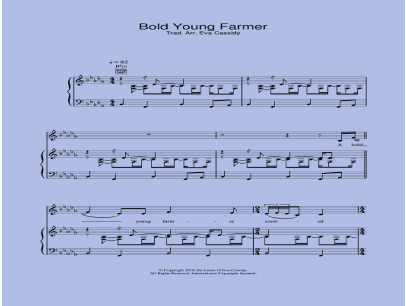
![]()
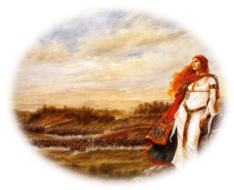 “Foggy Dew” is an English song. The first song of this title was of English origin, sometimes called “Foggy, Foggy Dew”, and is a lamentful ballad of a young lover. It was published on a broadside around 1815, though there are very many versions: Cecil Sharp collected eight versions. Burl Ives, who popularized the song in the United States in the 1940s, claimed that a version dated to colonial America. Ives was once jailed in Mona, Utah, for singing it in public, when authorities deemed it a bawdy song. BBC Radio likewise restricted broadcast of the song to programmes covering folk tunes or the works of Benjamin Britten. The tune is a late 18th or early 19th century revision of "When I First Came To Court", licensed in 1689.[30]
“Foggy Dew” is an English song. The first song of this title was of English origin, sometimes called “Foggy, Foggy Dew”, and is a lamentful ballad of a young lover. It was published on a broadside around 1815, though there are very many versions: Cecil Sharp collected eight versions. Burl Ives, who popularized the song in the United States in the 1940s, claimed that a version dated to colonial America. Ives was once jailed in Mona, Utah, for singing it in public, when authorities deemed it a bawdy song. BBC Radio likewise restricted broadcast of the song to programmes covering folk tunes or the works of Benjamin Britten. The tune is a late 18th or early 19th century revision of "When I First Came To Court", licensed in 1689.[30]
When I was a bachelor, I liv'd all alone
I worked at the weaver's trade
And the only, only thing that I ever did wrong
Was to woo a fair young maid.
I wooed her in the wintertime
And in the summer, too
And the only, only thing that I did that was wrong
Was to keep her from the foggy, foggy dew.
One night she came to my bedside
When I was fast asleep.
She laid her head upon my bed
And she began to weep.
She sighed, she cried, she damn near died
She said what shall I do?
So I hauled her into bed and covered up her head
Just to keep her from the foggy foggy dew.
So, I am a bachelor, I live with my son
and we work at the weaver's trade.
And every single time that I look into his eyes
He reminds me of that fair young maid.
He reminds me of the wintertime
And of the summer, too,
And of the many, many times that I held her in my arms
Just to keep her from the foggy, foggy, dew.

![]()
 “Banks of the Roses," also known as "On the Banks of the Roses," is a traditional Irish ballad. This up-tempo song tells the story of a young man called Johnny, who serenades his lover and wittily muses on her father's disdain for him. As the song has been around for centuries, some variations exist. Sometimes Johnny views his lover with a flippant, devil-may-care attitude; in other versions, his lover's story ends with a macabre twist.[31]
“Banks of the Roses," also known as "On the Banks of the Roses," is a traditional Irish ballad. This up-tempo song tells the story of a young man called Johnny, who serenades his lover and wittily muses on her father's disdain for him. As the song has been around for centuries, some variations exist. Sometimes Johnny views his lover with a flippant, devil-may-care attitude; in other versions, his lover's story ends with a macabre twist.[31]
His traditional Irish tune began its life as a limerick, a humorous verse of five lines. "The Banks of the Roses" evolved from limerick to folk song by the end of the 1700s. The earliest known appearance of the song is in 1790 as part of the Madden ballad collection, a historical volume documenting 18th- and 19th-century ballads. Variations of the song have been found in Ireland, Scotland, the United States and Canada. Famous recordings include Seamus Ennis's "The Banks of the Roses" and Lizzie Higgins's "The Banks of Red Roses."
In its most common form, "Banks of the Roses" tells a loose narrative from the perspective of Johnny, a young lover. On rosy banks, Johnny serenades his unnamed love with his fiddle. In the middle of the song, Johnny's lover sighs and asks him if he will leave her, telling him, "When I was a young lass, I heard my father say/That he'd rather see me dead and buried in the clay/ Sooner than be married to any runaway." Johnny quips that he is no runaway and that he "can take a good glass or leave it alone," meaning that he can forgo drink if he'd like. He says that if his lover's father doesn't like him, he can keep her -- he'll find another. Johnny then muses that that if he ever does get married, it will be on the banks of the roses "in the month of May/When the leaves are green and the meadows/They are gay."
In the original version of "Banks of the Roses," Johnny takes his lover to a cave and shows her her own grave. He then kills her and buries her body there. The Traditional Ballad Index, a scholarly database of historical ballads, speculates that singers enjoyed the song's tune and its first verses, but shied away from themes of murder. As such, most modern iterations of the song feature independently circulating verses without the lover's murder. Some versions name Johnny's lover "Jeannie." Many small variants exist among the lyrics, mostly as single-word substitutions like "violin" for "fiddle" or "bottle" for "glass." There is a traditional English song titled "The Banks of the Sweet Primroses," but it shares no relation to "The Banks of the Roses."
Though the titles are very similar, this is not related to The Banks of the Sweet Primroses, which is an English tune. [32]
On the banks of the Roses,
My love and I sat down,
And I took out my violin
To play my love a tune,
In the middle of the tune,
Oh, she sighed and she said,
O-ro, Johnny, lovely Johnny,
Would you leave me?
Oh, when I was a young man
I heard my father say,
That he'd rather see me dead
And buried in the clay,
Sooner than be married
To any runaway,
By the lovely sweet Banks
of the Roses.
Oh, then I am no runaway
And soon I'll let them know,
I can take a good glass
Or can leave it alone;
And the man that does not like me
He can keep his daughter at home
And young Johnny will go roving
with another.
And if ever I get married
'Twill be in the month of May,
When the leaves they are green
And the meadows they are gay;
And I and my true love
Can sit and sport and play
On the lovely sweet Banks
of the Roses.[33]
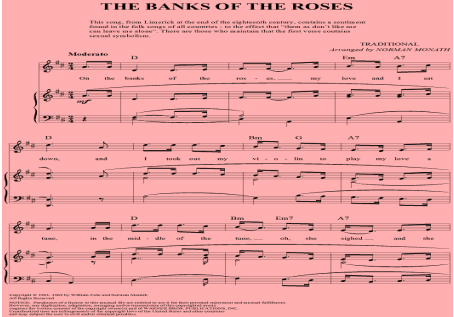
![]()
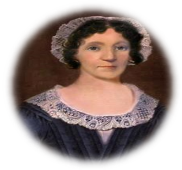 The song 'I Love my Jean' was inspired by Robert Burns's wife, Jean Armour (1767-1834) and composed shortly after the couple's marriage in the Spring of 1788.[34]
The song 'I Love my Jean' was inspired by Robert Burns's wife, Jean Armour (1767-1834) and composed shortly after the couple's marriage in the Spring of 1788.[34]
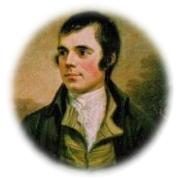 It is thought that the couple had previously contracted an 'irregular' marriage (by mutual agreement alone) in 1786.
It is thought that the couple had previously contracted an 'irregular' marriage (by mutual agreement alone) in 1786.
However, Jean's strictly religious parents disapproved of the poet and took steps to dissolve the union. Prior to the couple's eventual marriage in 1788, Jean gave birth to two sets of twins. Only one child, Burns's eldest son Robert, survived infancy.
It would appear that following the success of the Kilmarnock and Edinburgh editions Poems, Chiefly in the Scottish Dialect (1786; 1787), and as a consequence of Jean's recurring pregnancies, the Armours eventually accepted Robert Burns as their son-in-law.
Despite Burns's many dalliances with other women, Jean remained a faithful wife. The couple had nine children together, the last of whom was born on the day of Robert Burns's funeral on the 25th July 1796.
Sadly only three of their children survived to adulthood. This song, then, is a sincere expression of Robert Burns's affection for Jean Armour, 'the lassie I lo'e best'.
Of a' the airts the wind can blaw,[35]
I dearly like the West;
For there the bony Lassie lives,
The Lassie I lo'e best:
There's wild-woods grow, and rivers row,
And mony a hill between;
But day and night my fancy's flight
Is ever wi' my Jean.
I see her in the dewy flowers,
I see her sweet and fair;
I hear her in the tunefu' birds,
I hear her charm the air:
There's not a bony flower that springs
By fountain, shaw, or green;
There's not a bony bird that sings
But minds me o' my Jean.

![]()
This work includes Traditional Love songs of English – speaking countries such as England, Scotland, Wales, Ireland, Canada, Australia, New Zealand, the United States of America and others.
The topic of the songs is rather different. You can find songs about true love, sad and tragic love, unhappy love, false love and seduction, unrequited love, the battle of the sexes.
These songs touch people in a way that nothing else can. They can sway the most prideful person to forgive. Love songs help you remember when and why you fell in love. Love songs are for every season, every person, and every relationship.
Information Sources
- www.ann-burnett.suite101.com/
- www.bbc.co.uk/scotland
- www.contemplator.com
- www.ehow.com
- www.en.wikipedia.org
- www.EzineArticles.com
- www.freekidsmusic.com
- www.heavenlyharpist.com
- www.leoslyrics.com
- www.lyricsdog.eu
- www.6lyrics.com
- www.makingmusicfun.net
- www.mysongbook.de
- www.robertburns.org
- www.soundexp.com
- www.the-tudors.org.uk
- www.traditionalmusic.co.uk
- Encyclopedia Britannica 2006 Ready Reference, CD
- “Mother Goose Rhymes", Moscow “Raduga Publishers”, 1988
- Е.Г. Хоменко, О.М. Шерстюк “Valentine’s Day”/ Бібліотечка журналу “Іноземні мови” -№2, К.: Ленвіт, 2001
[1] http://www.ehow.com/how_4485801_sing-love-songs.html
[2] http://www.soundexp.com/history-of-love-songs#ancient
[3] http://en.wikipedia.org/wiki/Love_song
[4] http://EzineArticles.com/?expert=Anna_M_Everskemper
[5] http://www.soundexp.com/history-of-love-songs
[7] http://www.contemplator.com/love.html
[8] http://www.contemplator.com/love.html
[9] www.A Bicycle Built for Two - American Children's Songs - The USA - Mama Lisa's World Children's Songs and Rhymes from Around the World.htm
[10] http://ann-burnett.suite101.com/new-robert-burns-museum-opens-in-alloway-scotland-a333259
[11] http://en.wikipedia.org/wiki/A_Red,_Red_Rose.htm
[12] http://en.wikipedia.org/wiki/Greensleeves
[13] http://www.heavenlyharpist.com/
[14] http://www.the-tudors.org.uk/greensleeves.htm
[15] http://www.songfacts.com/
[16] http://en.wikipedia.org/wiki/Greensleeves
[17] http://en.wikipedia.org/wiki/File:Oh!_Susanna_1.jpg
[18] http://folkmusic.about.com/lr/folk_songs/241740/1/
[19] http://en.wikipedia.org/wiki/The_Riddle_Song
[20] http://best-scottish-tours.blogspot.com/2009/04/scottish-song-annie-laurie.html
[21] http://en.wikipedia.org/wiki/Annie_Laurie
[22] http://mysongbook.de/msb/songs/a/a_titel.html#anlink
[23] http://makingmusicfun.net/htm/mmf_music_library_mmf_songbook_index.htm
[24] http://en.wikipedia.org/wiki/Billy_Boy
[25] http://en.wikipedia.org/wiki/All_Around_My_Hat_%28song%29
[26] http://www.traditionalmusic.co.uk/traditional-music/
[27] http://www.6lyrics.com/a_bold_young_farmer-lyrics-eva_cassidy.aspx
[28] http://en.wikipedia.org/wiki/A_Brisk_Young_Sailor_Courted_Me
[29] http://lyricsdog.eu/lyrics/892706
[30] http://en.wikipedia.org/wiki/Foggy_Dew
[31] http://www.ehow.com/list_7653234_banks-roses.html
[32] http://www.contemplator.com/folk.html
[33] http://www.leoslyrics.com/eula.php
[34] http://www.bbc.co.uk/scotland/
[35] http://www.robertburns.org/works/


про публікацію авторської розробки
Додати розробку
